AI Voice Generator for Customer Support
Learn how Gen AI models power voice generation for customer support, along with their benefits and limitations, so you can plan your integration accordingly.
7/4/2025
artificial intelligence
10 mins
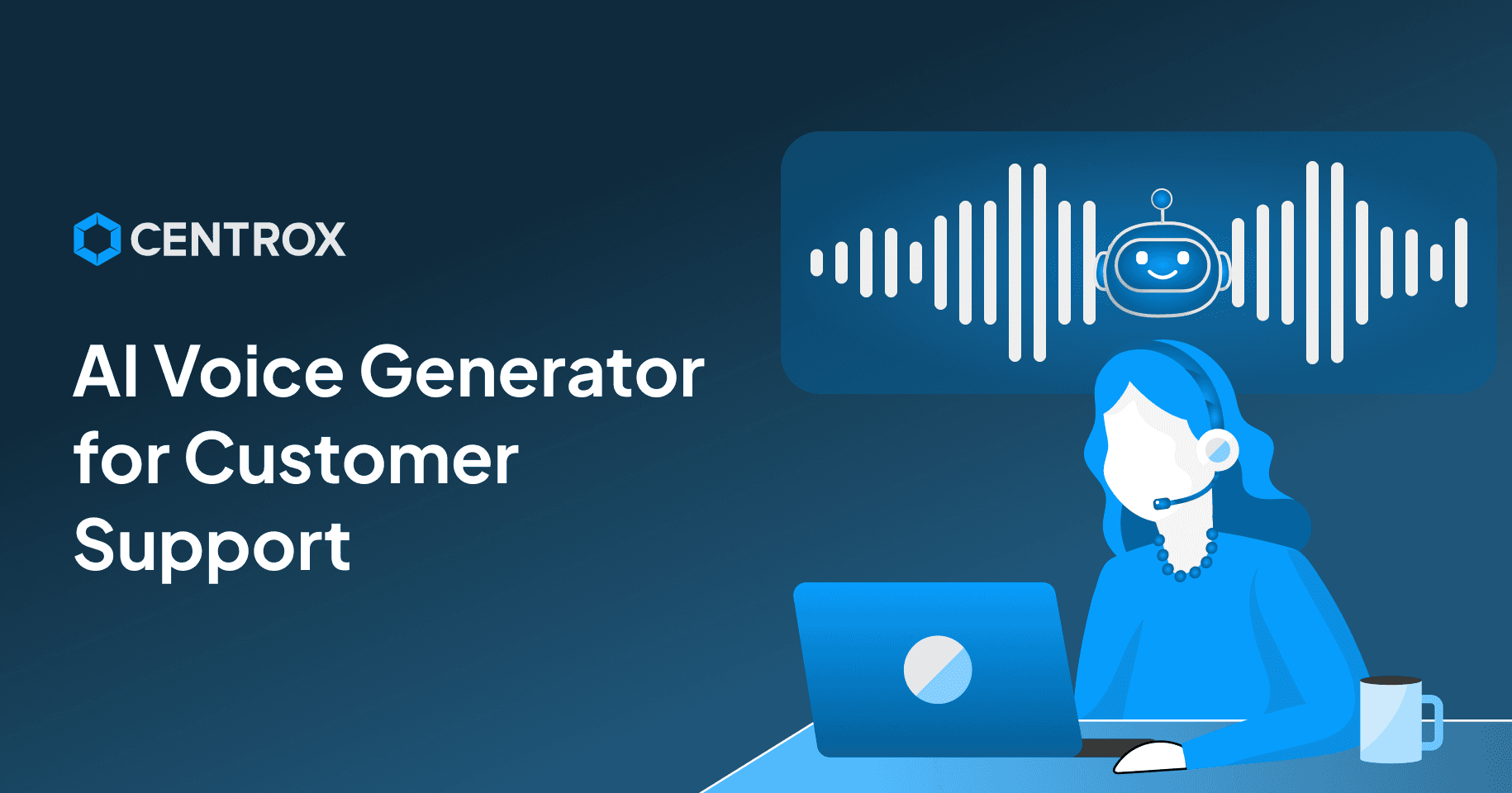
With the AI voice generation solutions now available, we have observed an enhanced user experience, thanks to improved accessibility. These AI voice-driven solutions are more convenient for people belonging to different ethnicities and for those having a visual impairment, since through this, they can acquire voice support in their native language.
AI voice generation is not just uplifting accessibility by making the use of AI technology easy and user-friendly, but it's also helping in speeding up tasks, saving resources, and ultimately cutting down costs by extending a single solution for handling voice-driven customer queries. These AI voice solutions can answer your repeated queries without getting overwhelmed or frustrated, extending support till you feel satisfied.
Let's dive deep into exploring AI voice generation by learning about what AI voice generation is, some common methodologies, applications, benefits, and limitations, which will help you understand how it will alleviate the customer support experience.
What is AI Voice Generation?
AI voice generation is basically the process of generating human like voices synthetically by using artificial intelligence techniques. Through the implementation of methodologies, we can benefit from machine-generated sounds that resemble how human speaks, and we can also adjust the tone. pitch, frequency of these AI-generated voices, based on our preference or requirements.
AI-generated voices provide us with a more controlled approach for generating voices as per our needs. For generating realistic voices, it might take text, audio, video, or all of them as input, and analyze the patterns to generate a coherent, comprehensive, and natural-sounding voice-based response.
Why do we need AI voice generation for customer support?
We can see the growing need for AI-assisted voice generation, especially for customer service support needs, as they can work as a single agent that can handle support conversations with multiple customers simultaneously without getting overwhelmed or tired. Whereas it's very difficult for traditional customer support agents to handle multiple customers at the same time, as this compromises their efficiency, quality of work, and leaves them feeling drained. If we hear it in the words of Rana el Kaliouby (AI thought leader and Deputy CEO at Smart Eye), he says:
"Conversational AI, especially voice-based systems, is not just a convenience anymore—it's becoming a necessity. The future of customer engagement will rely on hyper-personalized, voice-enabled experiences powered by AI."
So, essentially, we can anticipate AI voice generation optimizing workflows, reducing support response time, and scaling operations without constantly needing to hire or train new staff.
Methodologies For AI Voice Generation
For carrying out the responsibility to deliver AI-generated voices, we have several methodologies. Each methodology has its specific benefits, limitations, and best use case scenario. Below, we have mentioned the methodologies used for AI voice generation, which will help you get an overview of which methodology suits you well for your particular requirements:
Concatenative Speech Synthesis
- Working: Concatenative speech synthesis is one of the oldest methodologies used for generating speech artificially. This technique uses large databases of pre-recorded speech, segments them into typically phonemes, syllables, or words, and synthesizes new speech by selecting and combining these segments to form coherent-sounding sentences. (A.J et al., 1996)
- Benefits: This methodology produces natural-sounding voice outputs which has great audio quality, making it very useful for the application in which it is used.
- Limitation: This AI voice generation methodology lacks flexibility and therefore struggles to vary tone, emotional expression, or handle out-of-database words. Furthermore, the transition between these combined segments might sometimes sound unnatural or choppy.
- Use case: Concatenative speech synthesis methodology is commonly used for applications like GPS devices and voice-enabled IVR systems.
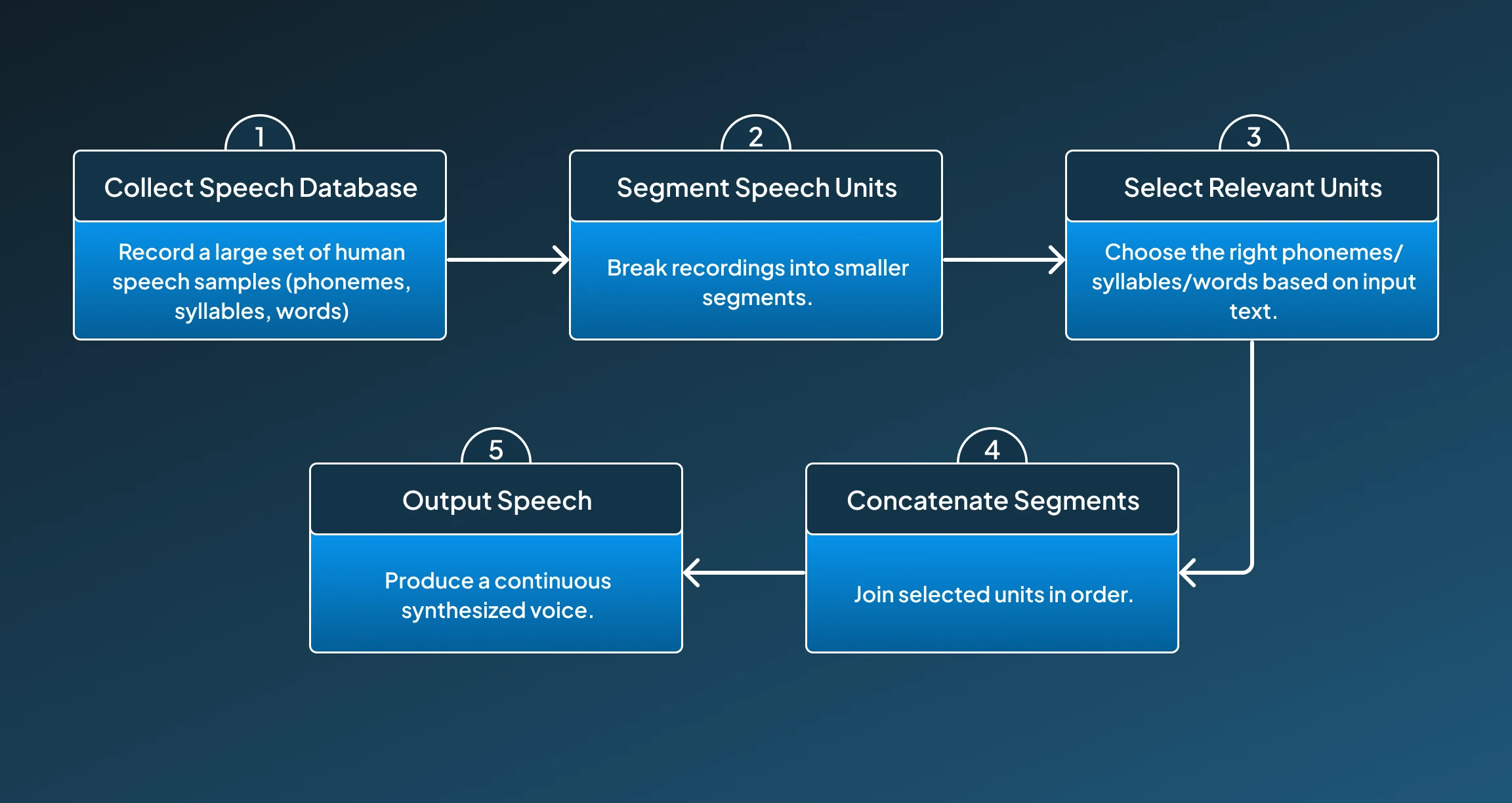
Formant Synthesis
- Working: Formant synthesis is a rule-based technique that works by modelling the human vocal tract by utilizing mathematical functions and generates speech. Instead of utilizing the actual human voice recordings, it simulates how sound is generated in the throat and mouth by manipulating the pitch, resonance, and noise.
- Benefits: The formant synthesis technique for AI voice generation is highly controllable and resource-efficient, as it doesn't require a large audio dataset for generating realistic voices.
- Limitations: Although this methodology offers great control but it sometimes tends to generate voices that could sound too robotic and mechanical, because of the absence of human nuances.
- Use case: It is commonly used for applications for visually impaired people and for embedded systems where computational resources are limited.
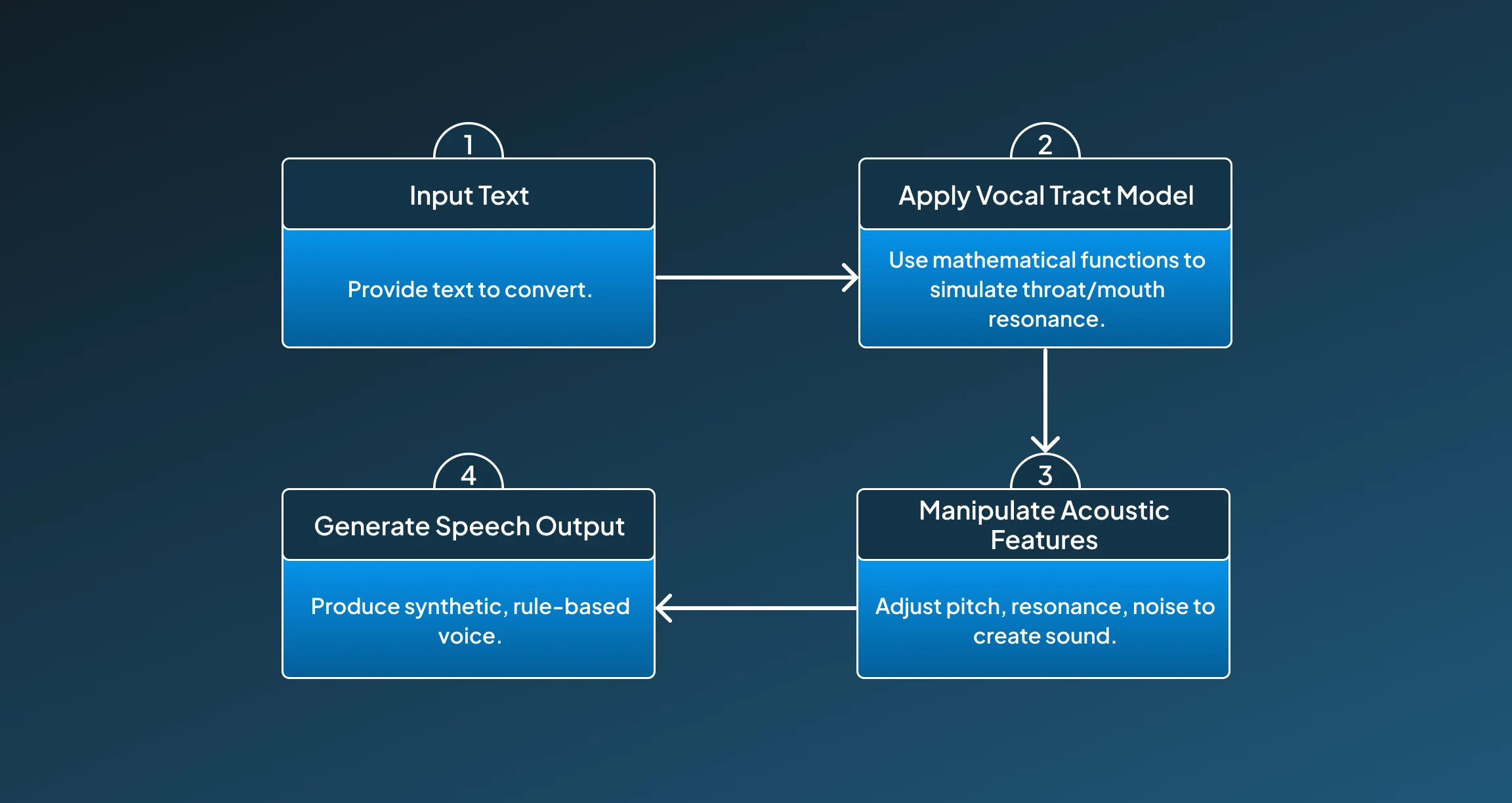
Statistical Parametric Speech Synthesis (SPSS)
- Working: Statistical Parametric Speech Synthesis was introduced as an improvement of earlier voice generation methodology. This was based on a machine learning technology that, specifically Hidden Markov Models (HMMs) that statistically models the patterns of human speech. These underlying systems are used to convert text into speech parameters like pitch, duration, and spectral features, and then generate a speech based on these parameters.
- Benefits: This AI voice generation approach is comparatively more flexible than concatenative synthesis, as it generates expressive voices by smoothly interpolating between speech units.
- Limitations: With all these benefits, this AI voice generation methodology holds limitations like generating voice outputs that are often muffled or unnatural compared to modern deep learning methods.
- Use case: This AI voice generation methodology was utilized for applications that require voice assistance, and also in some embedded systems applications.
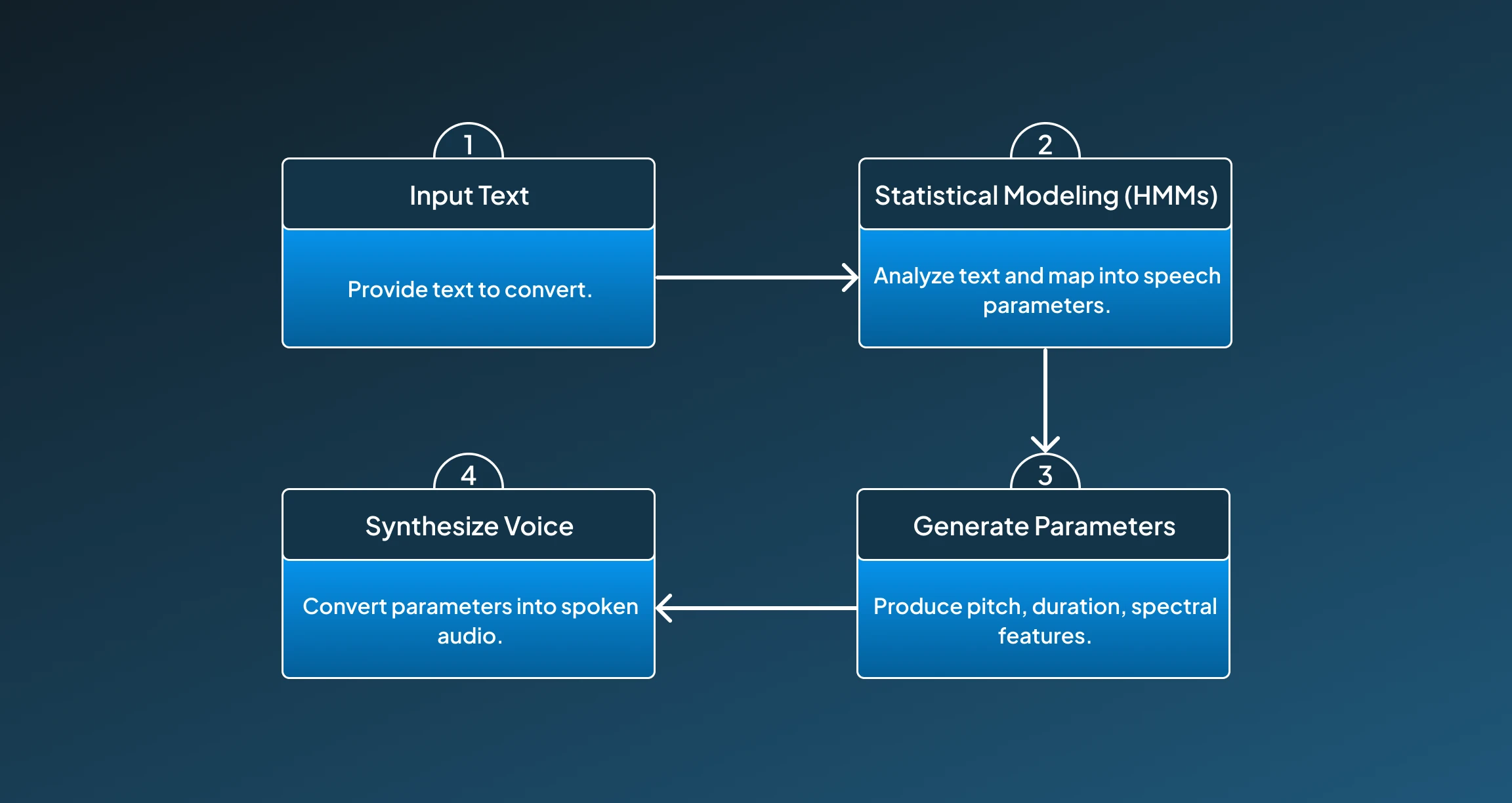
Neural Network-Based Text-to-Speech (TTS)
- Working: Neural Network-based text-to-speech generator introduced a major leap in voice synthesis by introducing quality and realistic voices. This methodology utilizes deep learning models to generate expressive voices. This process happens in two steps: In the first step, the input is converted into an intermediate representation like a mel-spectrogram, which represents sound, and then there is a vocoder that converts that spectrogram into an actual waveform. (Jonathan et al., 2017)
- Benefits: This AI voice generation model offers faster audio generation without compromising on voice quality.
- Limitations: However, this AI voice generation model is computationally expensive, as it requires significant resources for generating realistic, useful voices.
- Use case: This AI voice generation model is ideal for being implemented for applications like virtual assistants, customer Support Voice Bots, and E-learning & Audiobook Platforms.
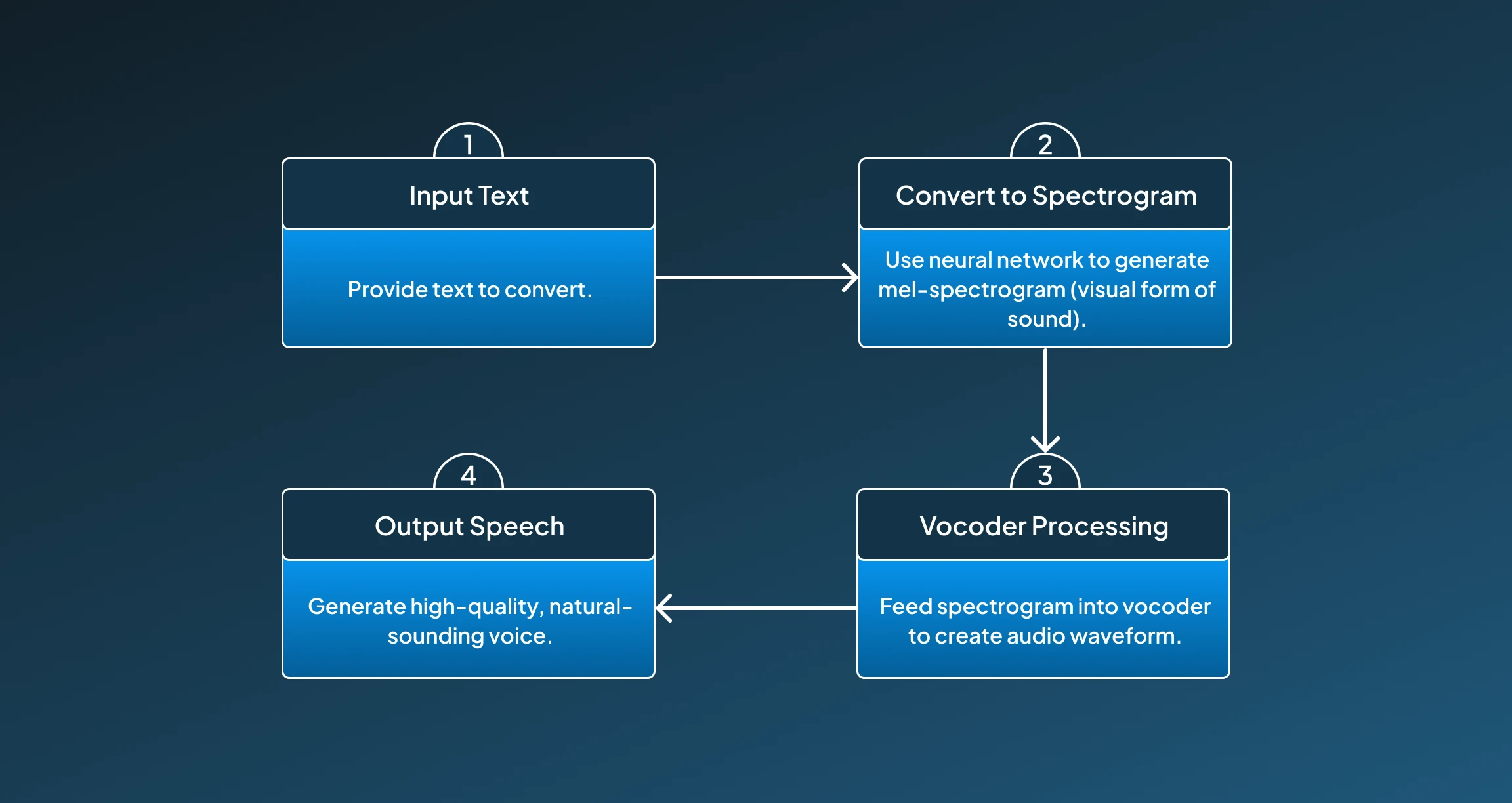
Voice Cloning and Style Transfer
- Working: Voice cloning is another advanced AI methodology that can generate a realistic voice of a specific person by using a few seconds of audio samples. It works by using speaker embedding, which is learnt from short samples, and applies it to generate speech in a particular voice. This process can be either few-shot (requires a small dataset of speech samples) or zero-shot .(Sercan et al., 2018)
- Benefits: This AI voice generation methodology has shown great performance in generating voices that resemble with original speakers, rhythm, and emotional style.
- Limitations: However, such a kind of application could raise ethical concerns as this can be used for malicious purposes, such as voice spoofing or identity misuse.
- Use cases: This methodology can be used for generating AI-based synthetic voices for applications like personalized assistants, dubbing, and content creation, to enhance the user experience more enhanced.
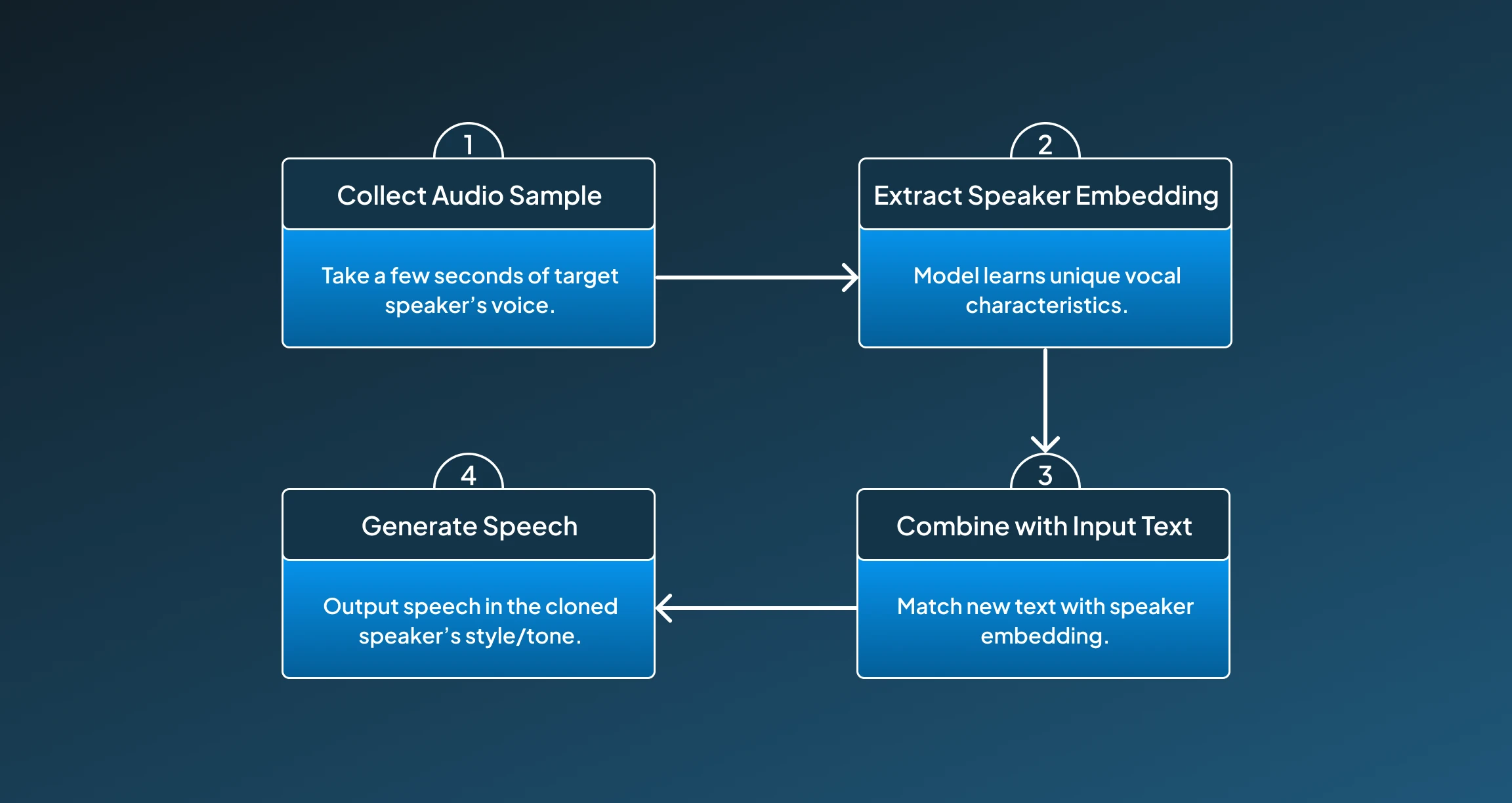
Applications for AI Voice Generation
AI voice generation is completely transforming how businesses used to interact with customers previously by becoming a convenient, fast, reliable, and more scalable alternative. By providing intelligent virtual receptionists to multilingual voice agents, these applications are enhancing accessibility then traditional customer service models. For your help, we have listed some of the most impactful real-world uses of AI-generated voices across various industries.
1. 24/7 Voice Support Agents
AI voice agents have recently gained much attention as they can efficiently handle customer inquiries around the clock without feeling burdened, even outside normal business hours, reducing the need for having live human agents.
Example: IBM Watson Assistant + Voice Gateway This 24/7 voice agent is actively being used by banks and telecom service providers to provide 24/7 voice support via phone calls, handling everything from FAQs to account-related queries.
2. Call Deflection & Intelligent IVR Systems
AI voice generation is now also powering smarter IVR (Interactive Voice Response) systems, as these are intelligent enough to understand the received audio and respond to it in a more natural, comprehensive tone, rather than using the traditional keypad-based systems.
Example: Cognigy.AI + Amazon Polly Telecom companies today are using it for 80% of Tier 1 support calls as these natural-sounding voice bots help customers navigate billing, service issues, and more.
3. Multilingual and Regional Language Support
To enhance global outreach and connectivity, these AI-generated voices can speak multiple languages or regional dialects, allowing businesses to connect and extend services to diverse audiences without hiring multilingual agents.
Example: Google Cloud TTS This multilingual and regional support AI voice agents are being utilized by Vodafone India to deploy support agents who can speak over 7 Indian languages, enabling them to get deeper engagement in local markets.
4. Order & Appointment Handling via Voice
AI Voice bots have become smart enough to confirm, reschedule, or cancel appointments or orders via phone calls, and by executing such tasks, they are reducing the workload on human agents.
Example: Mindsay (acquired by Laiye) + Microsoft Azure TTS An implementation of AI voice generation can be used in the travel and hospitality sector to automate the procedure of reservation confirmations, saving up to 40% in support costs and speeding up workflows.
5.Voice-Enabled Feedback Collection
Collection of feedback via calls after providing a service can be extremely tiring and frustrating if done manually. However, with an AI voice generation-driven tool, we can get an automated approach for handling the task of Post-interaction surveys, which makes it more interactive and easier to handle multiple interactions autonomously.
Example: Twilio Studio + TTS (like Amazon Polly) Mostly retail brands need customer feedback post providing a product or service to evaluate their performance to improve it. Here, this AI voice-enabled feedback collection can automatically collect voice surveys after product delivery or support interaction.
6. Virtual Receptionists and Front Desks
AI voice agents can today comprehensively answer inbound calls, greet customers, and route them to the appropriate department or resource, and eventually act as a smart automated receptionist and front desk for any organization.
Example: Avaya Conversational IVR with Nuance TTS Such AI voice-based applications are deployed by healthcare and insurance providers as virtual receptionists, especially during peak hours or pandemics when human staff are limited and patient or customer influx is high.
Conclusion
AI voice generation is changing the future dynamics of customer support by allowing businesses to deliver fast, consistent, and personalized service at scale. Contrary to human agents, AI voice bots can smartly handle multiple conversations simultaneously, operate 24/7, and speak in multiple languages of your choice, while maintaining a natural and empathetic tone.
From answering FAQs to confirming appointments or routing calls intelligently, these AI-powered voice agents have surprised us with their enhanced efficiency and reduced operational costs. With the rise of neural TTS models, companies now have access to highly realistic and expressive voice solutions that improve both customer experience and brand perception.
As demand for automation keeps growing, AI voice generators will become an integral part of modern support systems, not just a futuristic add-on, but a competitive necessity for businesses to stay ahead.
Are you ready to integrate AI voice into your support strategy and deliver customer experiences that never sleep? Get your confusion cleared by discussing with our AI experts at Centrox AI, and start your journey towards a smarter future.

Muhammad Haris Bin Naeem
Muhammad Harris Bin Naeem, CEO and Co-Founder of Centrox AI, is a visionary in AI and ML. With over 30+ scalable solutions he combines technical expertise and user-centric design to deliver impactful, innovative AI-driven advancements.
Do you have an AI idea? Let's Discover the Possibilities Together. From Idea to Innovation; Bring Your AI solution to Life with Us!
Your AI Dream, Our Mission
Partner with Us to Bridge the Gap Between Innovation and Reality.
